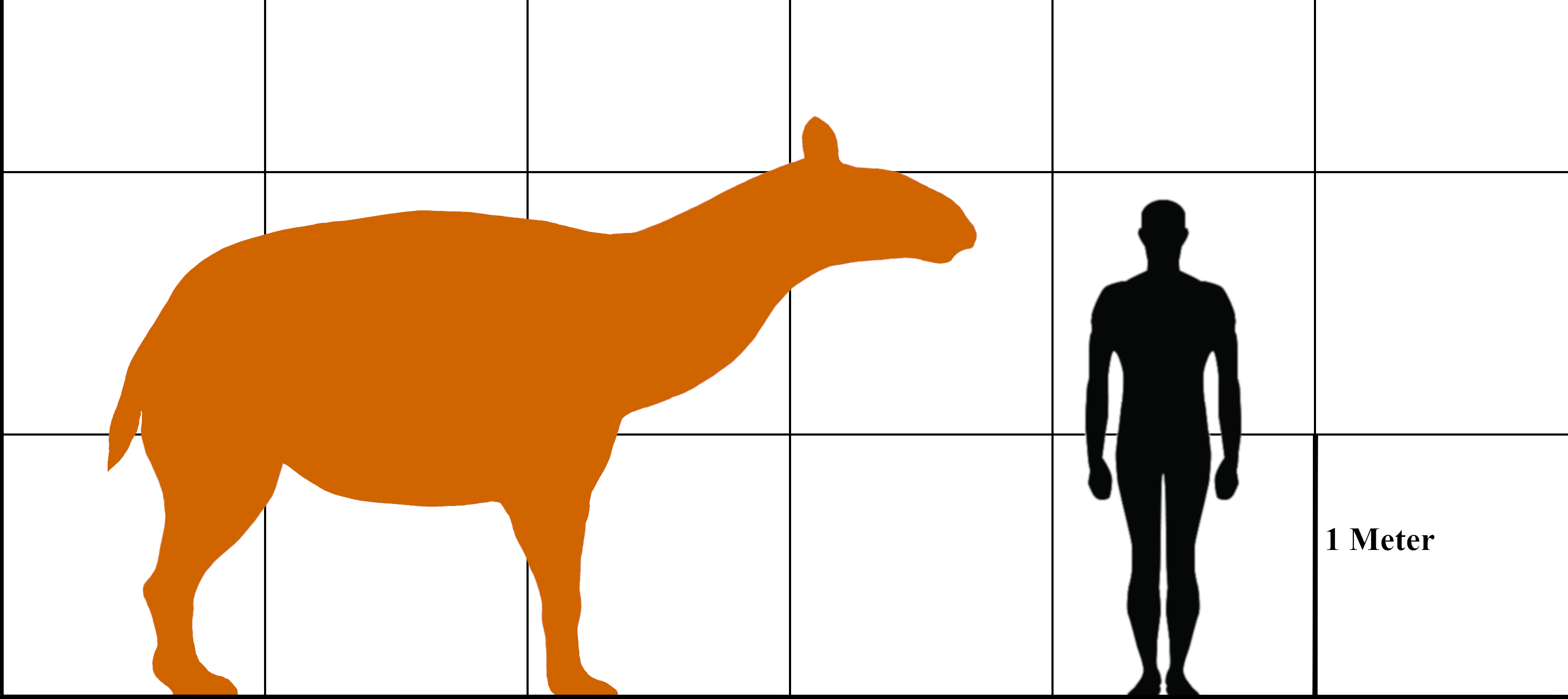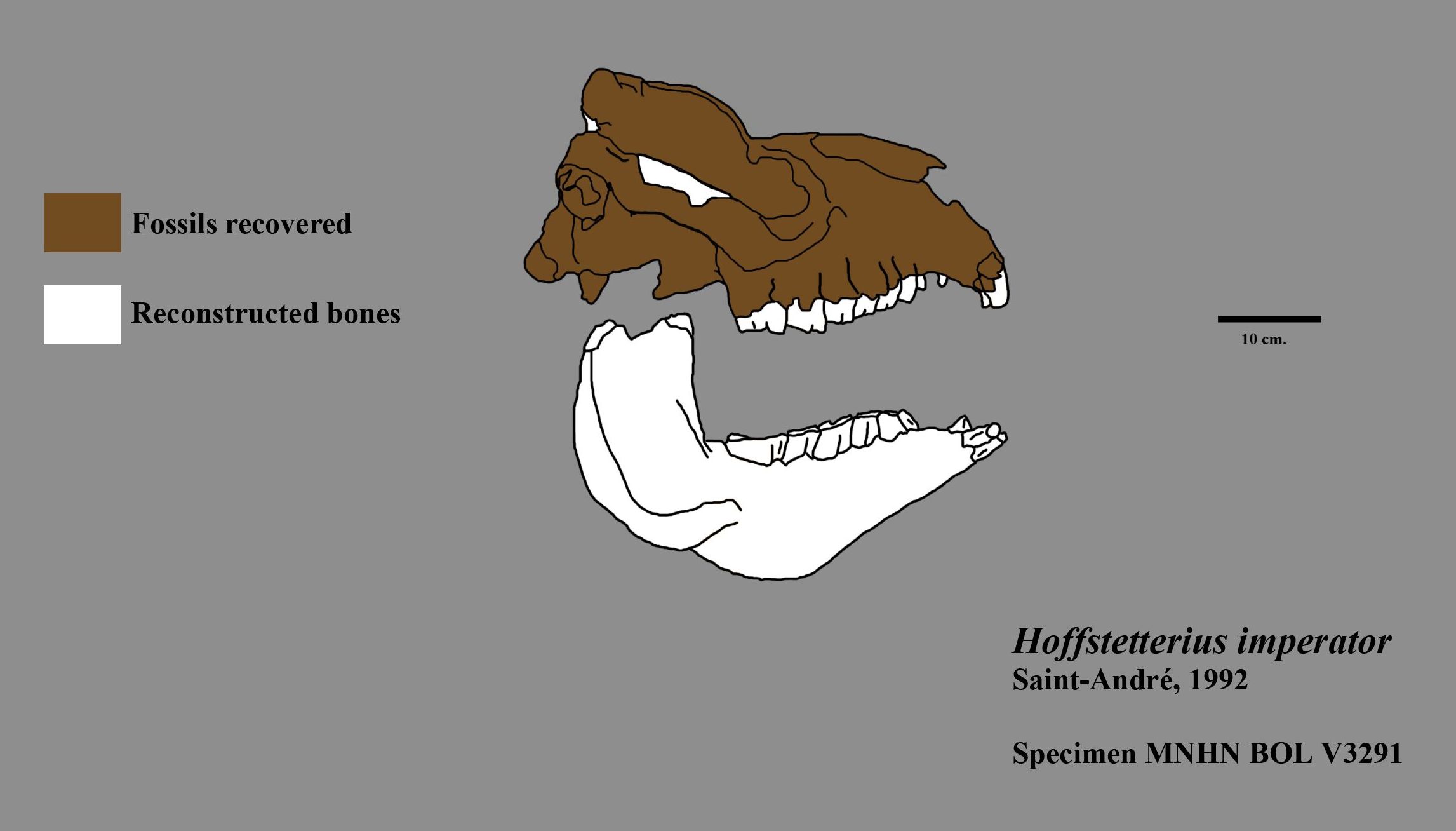|
Meridiungulata
South American native ungulates, commonly abbreviated as SANUs, are extinct ungulate-like mammals of controversial affinities that were indigenous to South America prior to the Great American Biotic Interchange. They comprise five major groups conventionally ranked as orders— Astrapotheria, Litopterna, Notoungulata, Pyrotheria, and Xenungulata—as well as some other taxa, such as Didolodontidae and Kollpaniidae. It has been proposed that some or all of the members of this group form a clade, named Meridiungulata, though the relationships of South American ungulates remain largely unresolved. The two largest groups of South American ungulates, the notoungulates and the litopterns, were the only groups to persist beyond the mid Miocene. Only a few of the largest species of notoungulates and litopterns survived until the end-Pleistocene extinctions. Though most SANUs lived in South America, astrapotheres and litopterns are known from Eocene aged deposits in the Antarctic Penin ... [...More Info...] [...Related Items...] OR: [Wikipedia] [Google] [Baidu] |
Astrapotheria
Astrapotheria is an extinct order of South American and Antarctic hoofed mammals that existed from the late Paleocene to the Middle Miocene, ."The uruguaytheriine Astrapotheriidae from the rich middle Miocene Honda Group of the upper Magdalena River valley in Colombia (...) are the youngest securely dated remains of that order in South America." Astrapotheres were large and rhinoceros-like animals and have been called one of the most bizarre orders of mammals with an enigmatic evolutionary history. This taxonomy of this order is not clear, but it may belong to Meridiungulata (along with Notoungulata, Litopterna, Pyrotheria and Xenungulata). In turn, Meridungulata is believed to belong to the extant superorder Laurasiatheria. Some scientists have regarded the astrapotheres (and sometimes the Meridiungulata as a whole) as members of the clade Atlantogenata. However, collagen and mitochondrial DNA sequence data analysed in 2015 places at least the notoungulates and litopterns fi ... [...More Info...] [...Related Items...] OR: [Wikipedia] [Google] [Baidu] |
Pyrotheria
Pyrotheria is an order of extinct meridiungulate mammals. These mastodon-like ungulates include the genera ''Baguatherium'', ''Carolozittelia'', ''Colombitherium'', ''Griphodon'', ''Propyrotherium'', ''Proticia'', and '' Pyrotherium''. They had the appearance of large, digitigrade, tapir-like mammals with relatively short, slender limbs and five-toed feet with broad, flat phalanges. Their fossils are restricted to Paleocene through Oligocene deposits of Brazil, Peru and Argentina. Some experts place the clade Xenungulata (which contains several genera, including '' Carodnia'') within Pyrotheria, even when dentition, although bilophodont in both orders, is very different. For most scholars, the two orders remain separated. The dentition is complete with strong, procumbent, chisel-shaped incisors, strong sharp-pointed canines, and low-crowned cheek teeth with bilophodont molars. The affinities of the Xenungulata remain uncertain. Affinities with the Dinocerata are strongly sup ... [...More Info...] [...Related Items...] OR: [Wikipedia] [Google] [Baidu] |
Perissodactyl
Odd-toed ungulates, mammals which constitute the taxonomic order Perissodactyla (, ), are animals—ungulates—who have reduced the weight-bearing toes to three (rhinoceroses and tapirs, with tapirs still using four toes on the front legs) or one (equines, third toe) of the five original toes. The non-weight-bearing toes are either present, absent, vestigial, or positioned posteriorly. By contrast, the even-toed ungulates bear most of their weight equally on four or two (an even number) of the five toes: their third and fourth toes. Another difference between the two is that odd-toed ungulates digest plant cellulose in their intestines rather than in one or more stomach chambers as even-toed ungulates, with the exception of Suina, do. The order includes about 17 species divided into three families: Equidae (horses, asses, and zebras), Rhinocerotidae (rhinoceroses), and Tapiridae (tapirs). Despite their very different appearances, they were recognized as related families ... [...More Info...] [...Related Items...] OR: [Wikipedia] [Google] [Baidu] |
Great American Interchange
The Great American Biotic Interchange (commonly abbreviated as GABI), also known as the Great American Interchange and the Great American Faunal Interchange, was an important late Cenozoic paleozoogeographic biotic interchange event in which land and freshwater fauna migrated from North America via Central America to South America and vice versa, as the volcanic Isthmus of Panama rose up from the sea floor and bridged the formerly separated continents. Although earlier dispersals had occurred, probably over water, the migration accelerated dramatically about 2.7 million years ( Ma) ago during the Piacenzian age. It resulted in the joining of the Neotropic (roughly South American) and Nearctic (roughly North American) biogeographic realms definitively to form the Americas. The interchange is visible from observation of both biostratigraphy and nature ( neontology). Its most dramatic effect is on the zoogeography of mammals, but it also gave an opportunity for reptiles, amphibians ... [...More Info...] [...Related Items...] OR: [Wikipedia] [Google] [Baidu] |
Litopterna
Litopterna (from grc, λῑτή πτέρνα "smooth heel") is an extinct order of fossil hoofed mammals from the Cenozoic era. The order is one of the five great orders of South American ungulates that were endemic to the continent, until the Great American Biotic Interchange brought new ungulate species. Like other endemic South American mammals, their relationship to other mammal groups had long been unclear, but recent genetic and proteomic evidence indicates that their closest living relatives are Perissodactyls (odd-toed ungulates) including horses, rhinoceros, and tapirs, and that litopterns are closely related to notoungulates, another widespread group of South American ungulates. There were two major groups of litopterns: Proterotheriidae and Macraucheniidae. Proterotheriids were medium to large animals that evolved adaptations for fast running, and occupied a variety of niches that elsewhere were filled by animals such as goats and antelopes, mouse deer, and h ... [...More Info...] [...Related Items...] OR: [Wikipedia] [Google] [Baidu] |
Xenungulata
Xenungulata ("strange ungulates") is an order of extinct and primitive South American hoofed mammals that lived from the Late Paleocene to Early Eocene (Itaboraian to Casamayoran in the SALMA classification). Fossils of the order are known from deposits in Brazil, Argentina, Peru, and Colombia. The best known member of this enigmatic order is the genus '' Carodnia'', a tapir-like and -sized animal with a gait similar to living African elephants. Description Xenungulates are characterized by bilophodont M1–2 and M1–2, similar to pyrotheres, and complex lophate third molars, similar to uintatheres. Though other relationships, to arctocyonids for example, have been suggested, no proofs thereof have been found. The foot bones of xenungulates were short and robust and their digits terminated in broad, flat, and unfissured hoof-like unguals, quite unlike any other meridiungulates. The discovery of '' Etayoa'' in Colombia made it clear that xenungulates are distinct from ... [...More Info...] [...Related Items...] OR: [Wikipedia] [Google] [Baidu] |
Ungulate
Ungulates ( ) are members of the diverse clade Ungulata which primarily consists of large mammals with hooves. These include odd-toed ungulates such as horses, rhinoceroses, and tapirs; and even-toed ungulates such as cattle, pigs, giraffes, camels, sheep, deer, and hippopotamuses. Cetaceans such as whales, dolphins, and porpoises are also classified as even-toed ungulates, although they do not have hooves. Most terrestrial ungulates use the hoofed tips of their toes to support their body weight while standing or moving. The term means, roughly, "being hoofed" or "hoofed animal". As a descriptive term, "ungulate" normally excludes cetaceans as they do not possess most of the typical morphological characteristics of other ungulates, but recent discoveries indicate that they were also descended from early artiodactyls. Ungulates are typically herbivorous and many employ specialized gut bacteria to allow them to digest cellulose. Some modern species, such as pigs, are omnivor ... [...More Info...] [...Related Items...] OR: [Wikipedia] [Google] [Baidu] |
Notoungulata
Notoungulata is an extinct order of mammalian ungulates that inhabited South America from the early Paleocene to the Holocene, living from approximately 61 million to 11,000 years ago. Notoungulates were morphologically diverse, with forms resembling animals as disparate as rabbits and rhinoceroses. Notoungulata are the largest group of South American native ungulates, with over 150 genera in 14 families having been described, divided into two major subgroupings, Typotheria and Toxodontia. Notoungulates first diversified during the Eocene. Their diversity declined during the Late Neogene, with only the large toxodontids persisting until the end of the Pleistocene. Collagen analysis suggests that notoungulates are closely related to litopterns, another group of South American ungulates, and their closest living relatives being perissodactyls (odd-toed ungulates), including rhinoceroses, tapirs and equines. but their relationships to other South American ungulates are uncertain ... [...More Info...] [...Related Items...] OR: [Wikipedia] [Google] [Baidu] |
Macrauchenia Patachonica
''Macrauchenia'' ("long llama", based on the now-invalid llama genus, ''Auchenia'', from Greek "big neck") was a large, long-necked and long-limbed, three-toed native South American mammal in the order Litopterna. The genus gives its name to its family, the Macraucheniidae or "robust litopterns". Like other litopterns, it is most closely related to the odd-toed ungulates ( Perissodactyla), from which litopterns diverged approximately 66 million years ago. The oldest fossils in the genus date to the late Miocene, around seven million years ago, and ''M. patachonica'' disappears from the fossil record during the late Pleistocene, around 20,000-10,000 years ago. ''M. patachonica'' is one of the last and best known member of the family and is known primarily from the Luján Formation in Argentina, but is known from localities across southern South America. Another genus of macraucheniid '' Xenorhinotherium'' was present in northeast Brazil and Venezuela during the Late Pleistocene. Th ... [...More Info...] [...Related Items...] OR: [Wikipedia] [Google] [Baidu] |
Condylarth
Condylarthra is an informal group – previously considered an order – of extinct placental mammals, known primarily from the Paleocene and Eocene epochs. They are considered early, primitive ungulates. It is now largely considered to be a wastebasket taxon, having served as a dumping ground for classifying ungulates which had not been clearly established as part of either Perissodactyla or Cetartiodactyla, being composed thus of several unrelated lineages. Taxonomic history Condylarthra always was a problematic group. When Condylarthra was first described by , Phenacodontidae was the type and only family therein. , however, raised Condylarthra to an order and included a wide range of diverse placentals with generalized dentitions and postcranial skeletons. More recent researchers (i.e. post-WW2) have been more restrictive; either including only a limited number of taxa, or proposing that the term should be abandoned altogether. Due to their primitive characteristics condylar ... [...More Info...] [...Related Items...] OR: [Wikipedia] [Google] [Baidu] |
Didolodontidae
Didolodontidae is a possibly paraphyletic family of "condylarth" mammals known from the Paleocene to the late Eocene of South America.J. N. Gelfo. 2010. The "condylarth" Didolodontidae from Gran Barranca: history of the bunodont South American mammals until the Eocene-Oligocene transition. In R. H. Madden, A. A. Carlini, M. G. Vucetich, R. F. Kay (eds.), The Paleontology of Gran Barranca: Evolution and Environmental Change through the Middle Cenozoic of Patagonia 130-14 References Paleocene first appearances Eocene extinctions Prehistoric mammal families Condylarths Meridiungulata {{Paleo-mammal-stub ... [...More Info...] [...Related Items...] OR: [Wikipedia] [Google] [Baidu] |
Hoffstetterius
''Hoffstetterius'' is an extinct genus of toxodontid notoungulate mammal, belonging to the subfamily Toxodontinae whose remains were discovered in the Middle to Late Miocene ( Mayoan to Montehermosan) Mauri Formation in the La Paz Department in Bolivia.''Hoffstetterius'' at .org The only described species is the type ''Hoffstetterius imperator''.Saint-Andre, P. A. (1993). ''Hoffstetterius imperator'' ng, n. sp. du Miocène supérieur de l'Altiplano bolivien et le statut des Dinotoxodontinés (Mammalia, Notoungulata). Comptes rendus de l'Académie des scie ... [...More Info...] [...Related Items...] OR: [Wikipedia] [Google] [Baidu] |






